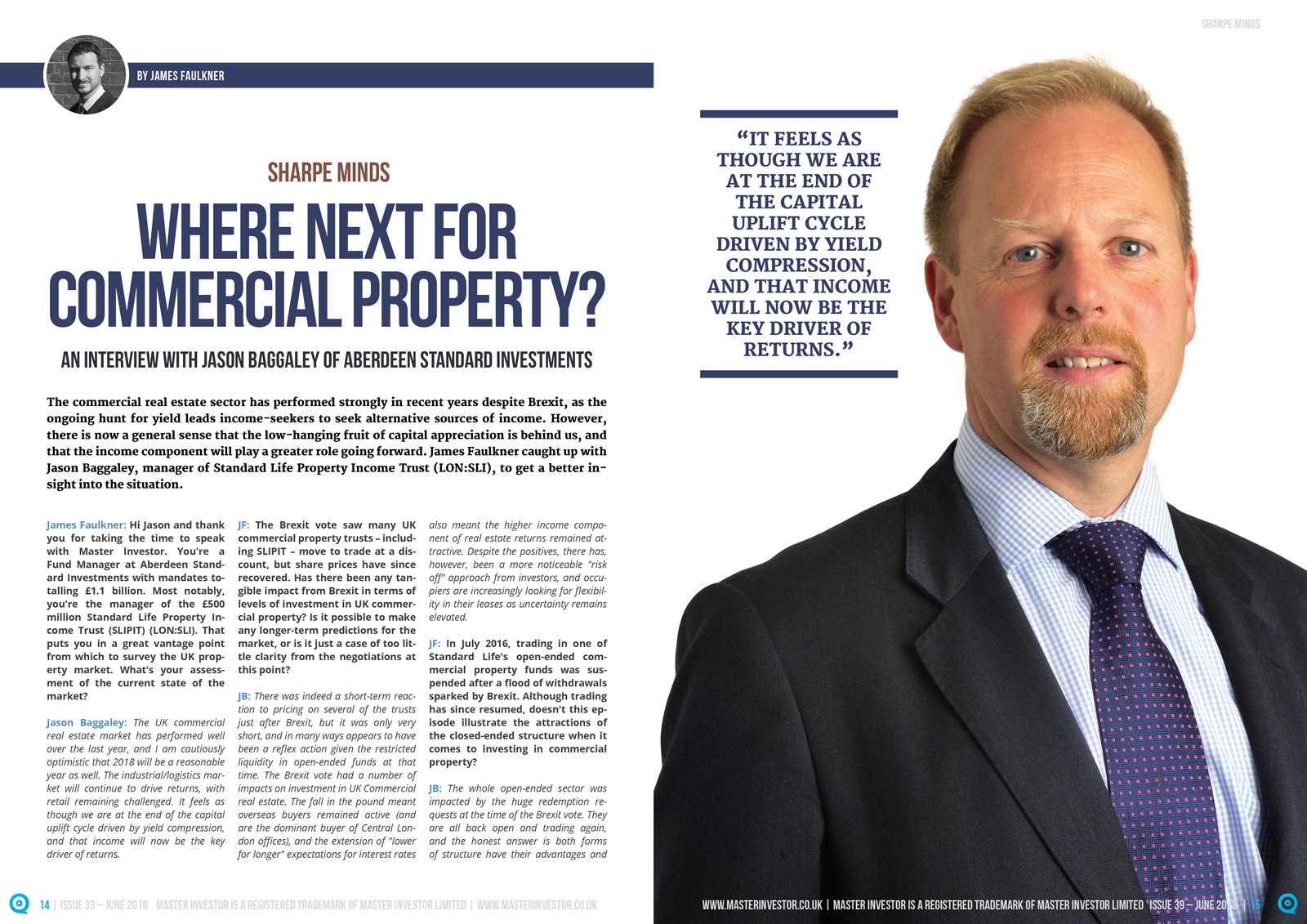Where next for commercial property?

MAGAZINE ARTICLE
This article first appeared in Issue 39 of Master Investor Magazine.
Click here to download the article as a printer-friendly PDF
|
Get this article and many more – for free! |
The commercial real estate sector has performed strongly in recent years despite Brexit, as the ongoing hunt for yield leads income-seekers to seek alternative sources of income. However, there is now a general sense that the low-hanging fruit of capital appreciation is behind us, and that the income component will play a greater role going forward. James Faulkner caught up with Jason Baggaley, manager of Standard Life Property Income Trust (LON:SLI), to get a better insight into the situation.
James Faulkner: Hi Jason and thank you for taking the time to speak with Master Investor. You’re a Fund Manager at Aberdeen Standard Investments with mandates totalling £1.1 billion. Most notably, you’re the manager of the £500 million Standard Life Property Income Trust (SLIPIT) (LON:SLI). That puts you in a great vantage point from which to survey the UK property market. What’s your assessment of the current state of the market?
Jason Baggaley: The UK commercial real estate market has performed well over the last year, and I am cautiously optimistic that 2018 will be a reasonable year as well. The industrial/logistics market will continue to drive returns, with retail remaining challenged. It feels as though we are at the end of the capital uplift cycle driven by yield compression, and that income will now be the key driver of returns.
JF: The Brexit vote saw many UK commercial property trusts – including SLIPIT – move to trade at a discount, but share prices have since recovered. Has there been any tangible impact from Brexit in terms of levels of investment in UK commercial property? Is it possible to make any longer-term predictions for the market, or is it just a case of too little clarity from the negotiations at this point?
JB: There was indeed a short-term reaction to pricing on several of the trusts just after Brexit, but it was only very short, and in many ways appears to have been a reflex action given the restricted liquidity in open-ended funds at that time. The Brexit vote had a number of impacts on investment in UK Commercial real estate. The fall in the pound meant overseas buyers remained active (and are the dominant buyer of Central London offices), and the extension of “lower for longer” expectations for interest rates also meant the higher income component of real estate returns remained attractive. Despite the positives, there has, however, been a more noticeable “risk off” approach from investors, and occupiers are increasingly looking for flexibility in their leases as uncertainty remains elevated.
JF: In July 2016, trading in one of Standard Life’s open-ended commercial property funds was suspended after a flood of withdrawals sparked by Brexit. Although trading has since resumed, doesn’t this episode illustrate the attractions of the closed-ended structure when it comes to investing in commercial property?
JB: The whole open-ended sector was impacted by the huge redemption requests at the time of the Brexit vote. They are all back open and trading again, and the honest answer is both forms of structure have their advantages and disadvantages. I consider myself fortunate that I do not have to worry about investor flows in the same way, so I can focus on remaining fully invested (in fact, we have some structural gearing so are more than 100% invested in effect), and I do not have investor flows impacting on investment decisions. That said, short-term volatility in share prices can be off-putting for investors, and large investor trading volumes can impact the discount/premium.
JF: Where does a commercial property fund fit into a portfolio and what are the attractions of commercial property vis-à-vis residential property?
JB: Commercial Real Estate can fulfil several roles in a portfolio but should be considered as a long-term investment in all of them. It can provide an attractive source of income (SLIPIT yields 5%), generated from rental income that is predictable and agreed under a contract rather than at the decision of the company as a dividend is. Most leases in the UK provide for upward-only rent reviews, which gives the opportunity to capture rental growth, but certainty of a base level for the duration of the lease. The “real” nature of the asset class means there is an ability to create value through asset management and refurbishment, and also that not all the value comes from the income stream from the tenants. Finally, the asset class can also provide diversification benefits, with a range of properties in different parts of the UK, let to different companies, in different sectors providing a balanced fund.
For most investors, a balanced commercial real estate fund is easy to access, and they already have exposure to the residential market, with their house being their largest asset. It is not yet as easy to access a diversified residential fund, and to invest directly in one or two assets only has risk.
JF: SLIPIT tends to focus on smaller properties outside central London with shorter leases. You also have a high weighting towards industrial property. Doesn’t this increase the risk profile of the trust, as opposed to peers with a greater focus on prime Central London property with longer leases?
JB: Central London offices is one of the most cyclical markets and looks expensive at the moment – rental levels are falling a bit and supply is increasing; it is one of our least favoured markets. We actually sold our last City office in early 2017 to reduce risk in this sector, although we have an open mind to reinvesting where we can find sufficient value – overseas money has reduced the yield to unacceptable levels for our purposes. My philosophy has to be to focus on good quality property in good locations let to good tenants. If one has that, then I believe the entry price is sufficiently attractive to reward one for the risk of shorter leases. Moving property is very expensive, time consuming, and disruptive, so if one has a property that meets the needs of a tenant, there is every opportunity to retain them in it. On the other hand, if it is a good property in a good location, then if they do leave, there is a good chance to re-let it. It is very easy to confuse lease duration for security of income, and the long lease indexed income has become a crowded trade.
JF: In SLIPIT’s most recent Annual Report & Accounts, you suggested that “the steady secure income component generated by the asset class is likely to be the key driver of returns over the next few years”. Does this mean that the outlook for capital growth looks weak?
JB: In short, yes. It is difficult to forecast with certainty currently given the unknown outcome and impact of Brexit, but we anticipate a fall in capital values, led by central London offices and poorer quality retail. These falls should be muted, however, with total returns remaining positive. The fact that supply remains constrained in most markets with very little development over the last 10 years, and the relatively attractive yield from commercial real estate in the low interest rate environment we are in, means there should not be a major correction, and any falls in capital values will be short-lived.
JF: The current yield on the shares is an attractive 5%. Is there also scope to grow the dividend in future, given that dividend cover is 104%?
JB: In the immediate future, I do not expect the dividend to grow – as you say, it is already at an attractive level. Last year, we sold out of a number of our higher yielding assets that had greater risk attached to them, and we are reinvesting but at slightly lower yields.
JF: I was surprised to hear that the team at Aberdeen Standard Investments collect their own rent, which presumably gives you a better feel for the underlying dynamics of the market. What other ways is Aberdeen Standard Investments adding value for SLIPIT shareholders?
JB: The recent merger means that the real estate team is very large: sat within a 30-metre radius of me is a huge amount of knowledge and experience in just about every market that I can benefit from. The scale of the company also enables us to have specialist knowledge in-house – for example, in development, tax and structuring, debt, and sustainability.
JF: There has been a lot of criticism levelled at the fund management industry due to high costs and ‘closet trackers’. However, it strikes me that the property sector is an area where portfolio managers can be truly active. How does your team go about researching investments and making investment decisions?
JB: We start with having a clear objective – in the case of SLIPIT, it is to provide an attractive level of income to our investors. We then set an investment strategy based around our in-house research and utilise the depth of resource in-house to implement it. We do not reference the benchmark in this process – but do apply a stock-specific bottom-up approach to select assets that will meet our objective. We try to have a strong relationship with our tenants and see them personally to ensure we continue to meet their needs so that we can retain them in our properties, and we also regularly review each asset for opportunities to create value through refurbishment or lease restructuring. SLIPIT has a 54% exposure to the industrial/logistics sector (versus the IPD/MSI Quarterly Index benchmark of 23%) and an underweight exposure to retail of 15% (versus 36% benchmark).
JF: How has last year’s merger of Aberdeen Asset Management and Standard Life affected the trust?
JB: On a day-to-day basis the merger has had no impact on the trust, with the same people doing the same things now as before. As mentioned earlier, it does give me access to a wider knowledge base in the office, and I am sure further benefits will come out as the integration progresses.


Comments (0)